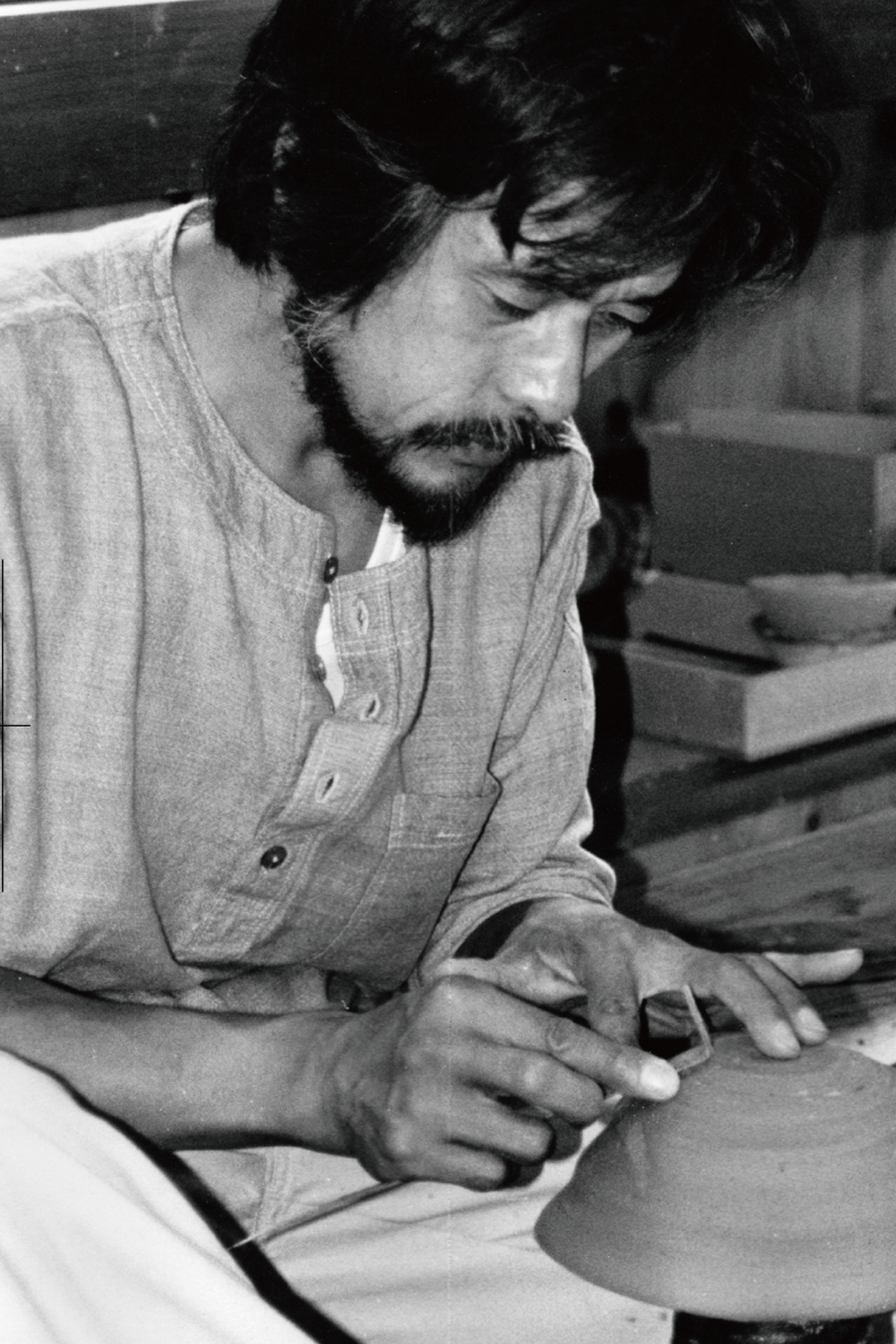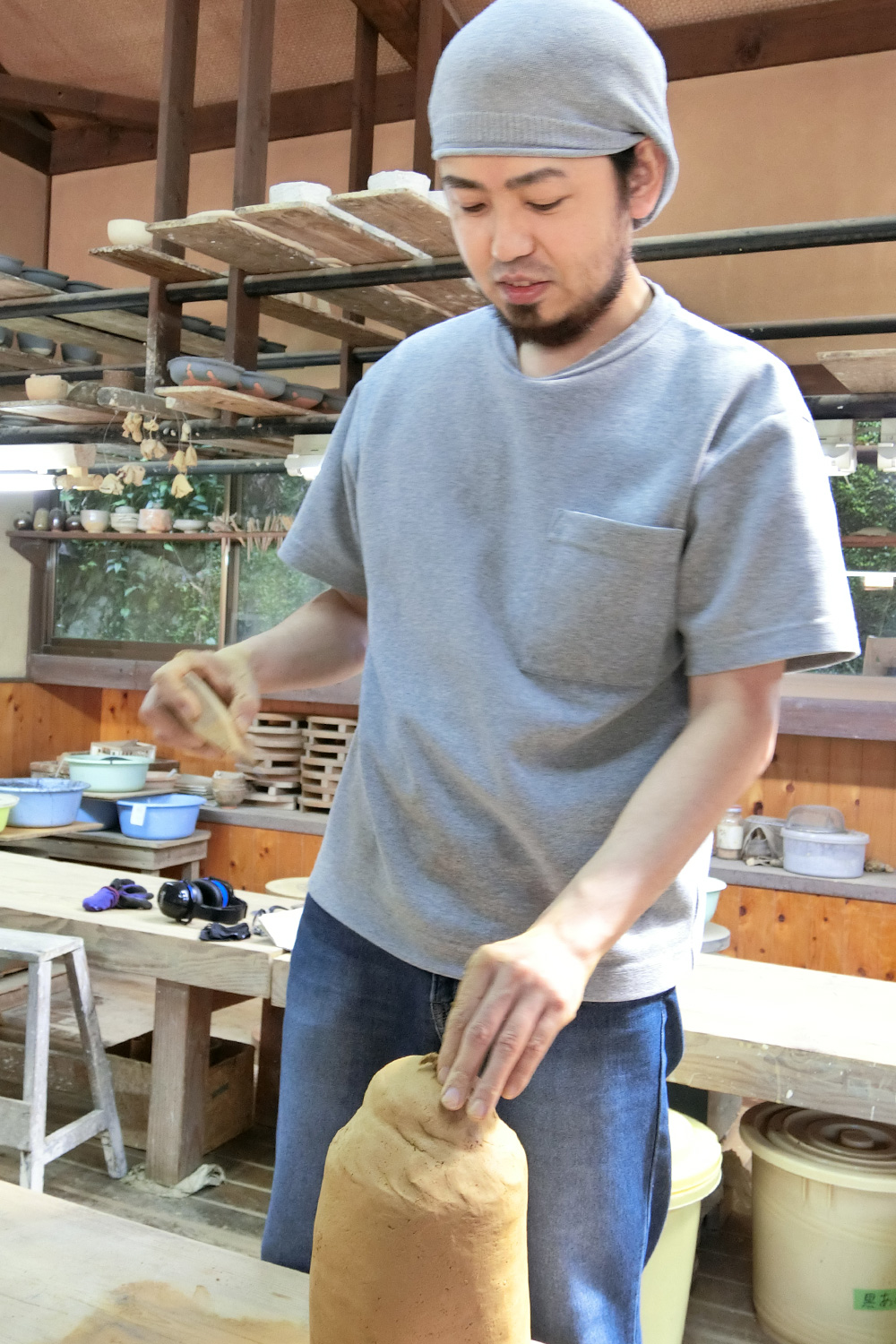
Karatsu Pottery has been made for over 400 years. Although Jinenbo Nakagawa died in 2011 his son Kyohei carries on the tradition of making Karstsu Pottery with passion, care and much effort. Kyohei believes that this passing on of the Passion is essential for the healthy development of the Tradition of Karatsu Pottery.

Jinenbo Nakagawa

Jinenbo Nakagawa
1953
・Born in Genkai Town, Saga Prefecture.
・His real name is Kenichi Nakagawa.
・He spent his childhood in poverty with his mother.
・After graduating from high school, he worked for a pharmaceutical company.
・He loved painting and his hungry spirit led him to leave his job, thinking that if he could become a potter, he would earn more money than a salaried worker and be respected as a master. After that, he was blessed with many encounters and his life became full of making pottery with a single-minded desire to make good pieces.
1977
・Trained for three and a half years at a Karatsu ware kiln
・Running 20km each way to work.
・As his own apprenticeship was three and a half years, he later decided that his apprentices should only stay for three and a half years. (A normal Apprenticeship is 10years.)
1982
・Built a split bamboo type climbing kiln at his birthplace and became independent.
・Save up funds for independence by peddling vegetables, etc., and collect materials(stones, bricks, scrap wood, etc.) for kilns and workshops.
・When he first started his own business, he used commercially available clay to make unoriginal pieces for souvenirs and gifts, but he was fascinated by the works of a contemporary artist and asked to teach him. Although he was not allowed to become an apprentice, the artist taught Jinenbo the secret of firing, saying, “It is firing that brings out the best of the clay and glaze.
・He began making pottery using red clay with high iron content, which was found when he buried his dog he used to have.
・By using a brush made of palm fibers to apply dark clay to the red clay body and firing it at high temperatures, the pottery with strong brush marks, that only a natural talented original artist can produce was born.
・He was discovered by Mr. Kusaomi Kuroda of Shibuya Kuroda Toen, who saw his brushstroke sake cup made by Jinenbo.
1985
・First solo exhibition at Shibuya Kuroda Toen, Tokyo (held annually since then)
Solo exhibition at Odakyu Department Store, Shinjuku, Tokyo (continued 13 times)
1986
・Successful firing of Chosen Karatsu using Clay from the local Old Kiln Site.
1989
・Solo exhibition at Hankyu Umeda store (held every year since then)
・1991: Built a new house and gallery. Built a new studio in 1992.
・In 1995, he built a dormitory for his apprentices, and the first apprentice joined in 1996, and the second in 1997. From this time on there were always 1 to 4 apprentices, including a live-in.
2000
・Engaged in the restoration of OKUGORAI, one of one of the type of Old Karatsu Tea Bowls.
・This is a challenge that is very different from the style of Jinenbo’s piece to date.
・He struggled to reproduce the loquat color of the original Okugorai.
2002
・Selected as one of “101 Tea Ceremony Artists: History and Contemporary Artists” by NHK Publishing.
・Since becoming independent, he had been firing the kiln six times a year by himself, but by this time he was firing more than 30 times a year with his apprentices. When he could get good tea bowls in a row, he often fired them in succession so that he would not forget this firing method. Although he kept the data, he fired by reading the atmosphere of the kiln based on the experience from the previous firing.
2003
・Engaged in Restoration of Ido Tea Bowl.
Selected for “Contemporary Japanese Ceramics” (organized by Toita Gakuen).
・Based on his experience in Okugorai, he thinks, “If I keep making Ido Tea Bowl with this, I might be able to make something really good.
・For tea bowls, the emphasis is on strength and dignity, rather than the boldness of the past, and the form is more important than the firing.
2004
・Selected as one of 109 people representing Japanese ceramic art by Abe Publishing Co.
Published in NHK Publication “Chawan: Heisei no Hyakunin100 Bowls”.
Appeared in NHK BS2 “Utsuwa Yume Kobo”.
2005
・Solo exhibition at Toumu, Kagoshima (held every other year since 1997)
2006
・20th exhibition at Shibuya Kuroda Toen, Tokyo
2009
・Participated in the exhibition “Fascinated by Old Karatsu – Challenges of Nine People” at the Kyushu Ceramic Museum.
・The exhibition was organized by the artists themselves. The focus was not to sell them as products but to display them as piece of art, and each exhibitor was particular about how to display their piece. Jinenbo wanted to call it “The Battle of the Nine”, but was rejected. That’s how he felt about it.
・He persuaded his son, Kyohei, to come back to the kiln due to his worsening medical condition. Hires an apprentice who was about to complete his training, as a craftsman and resumes pottery making with Kyohei.
・In 2010, he welcomed two new students. He also implements a new work schedule which includes rest days for the first time.
・2011 In conjunction with the “30th Anniversary Exhibition” and the visit of a group of buyers from New York, he created large vases(Tsubo), jugs(Mizusashi), flower vases(Hanaire), serving trays(Toban), etc with the last of his energy.
2011
・October: “30th Anniversary Exhibition” at Shibuya Kuroda Toen, Tokyo.
・On November 13 (one month before his death), he decided to build a completely new kiln combining a train kiln type and a continuous climbing kiln and started construction within the year. Under the guidance of a kiln builder and with the help of
his apprentices, he managed to complete it within the year, but he was unable to see the completion.
2011
・Dec. Died (Age 58)
2012
・Posthumous pieces exhibition at Shibuya Kuroda Toen, Tokyo
・The artisans became independent (graduated) and Kyohei also became independent, but since the late Jinenbo was such a prolific artist, for the next couple of years Kyohei exhibited his pieces alongside his father’s posthumous pieces. All Jinenbo’s posthumous pieces included Kiwamegaki.
TERMS: Kiwamegaki
Is an appraisal written directly onto the bottom or inside lid of the storage box. It usually records the Title and maker of the artwork as well as the appraiser’s name, seal and signature and date.
2013
・Retrospective exhibition at Toumu, Kagoshima, Japan Nakagawa Jinenbo Ichimon Exhibition” at Koudansha, Osaka (the 2nd exhibition in 2018) Posthumous Pieces Exhibition at Hankyu Umeda Main Store, Osaka
2014
・Exhibition of posthumous pieces at Bunkindo, Gifu (supporting artist: Kyohei Nakagawa)
2015
・A large blue Karatsu vase from the last year of his life was displayed. ”TSUBO: THE ART OF THE VESSEL Ancient-Present” at Joan B Mirviss LTD, New York, USA.
2016
・Nakagawa Jinenbo Requiem: The Last Jinenbo Exhibition” at Koudansha, Osaka
2019
・Retrospective exhibition at the Takasaki Suzuran (concurrent exhibition: Kyohei Nakagawa’s ceramics) Selected for “Korai Tea Bowl” (Korai Tea Bowl of the masters) in the separate volume of Flame Art by Abe Publishing Co.
・After the late Jinenbo’s death, the number of people who came into contact with Jinenbo’s kiln pieces for the first time gradually began to increase, and people are enjoying both the late Jinenbo’s and Kyohei’s pieces.
Kyohei Nakagawa

Kyohei Nakagawa
1983
Born in Genkai Town, Saga Prefecture.
2009
Apprenticed to my father, the late Nakagawa Jinenbo.
2012
Took over the kiln and studio and started making pottery.
2019
I started making pottery after my father, who was sick, persuaded me to take over his kiln, but as I continued to be involved in making pottery, I began to feel firsthand that his pieces were moving the hearts of many people.
Now, even after my father’s death, I am making pottery with a single-minded desire to meet the expectations of those who have paid attention to Nakagawa Jinenbo Kiln.
My pieces are not directly modeled after the ancient Karatsu, but I have tried to inherit the essence of Karatsu in my father’s pieces by interpreting it in my own way.
I am trying to find a way to combine my own style with that of my father, who had a sense of serenity and delicacy in his dynamic pieces, and to create vessels that would naturally accompany us in our daily lives.
I hope that my pottery will be of interest to those people who have never seen or handled this type of pottery.
2020年
My first solo exhibition was held at Gallery Tachibana (Nara) from October 31.
API error 190: Error validating access token: The session has been invalidated because the user changed their password or Facebook has changed the session for security reasons.